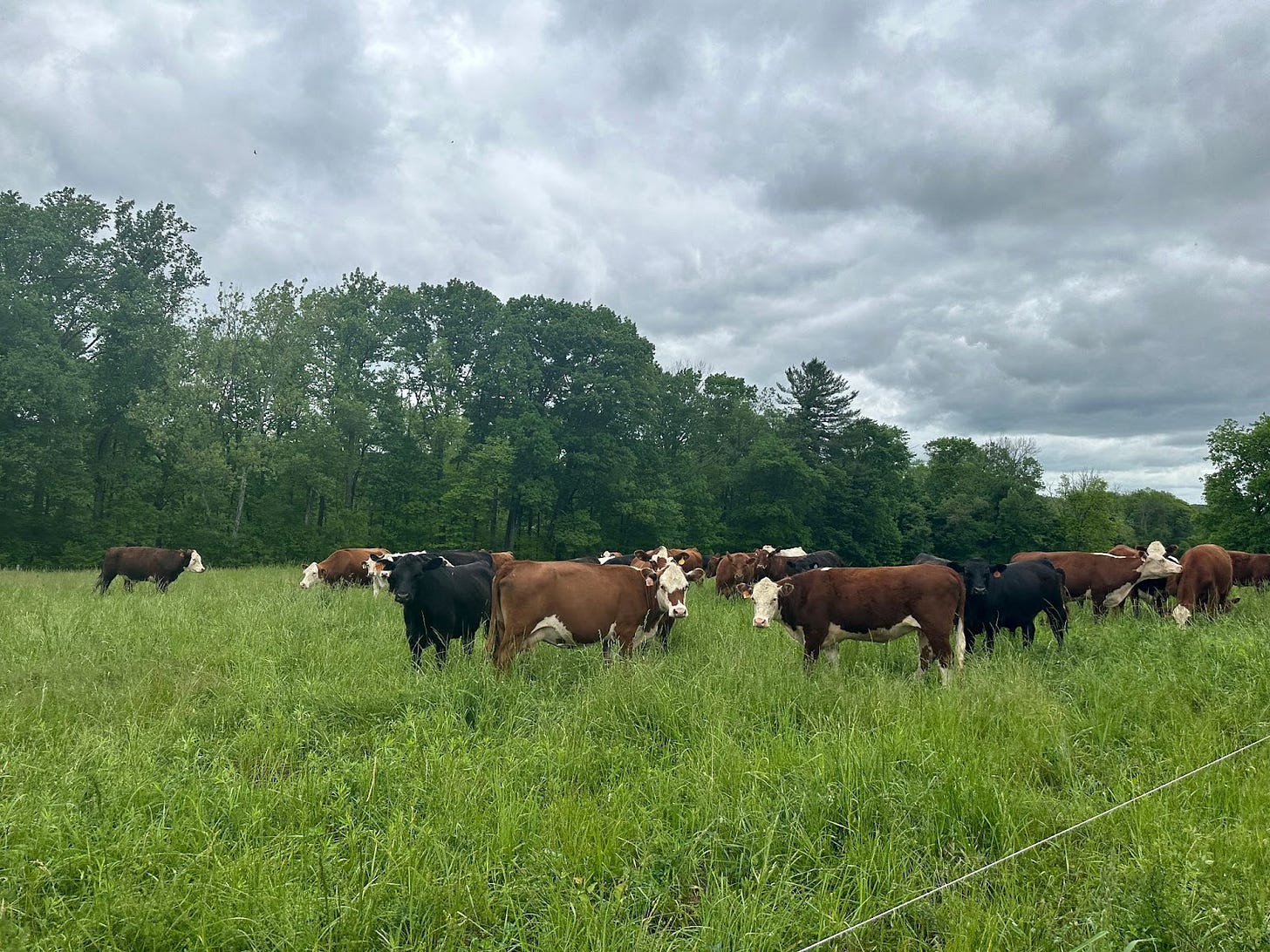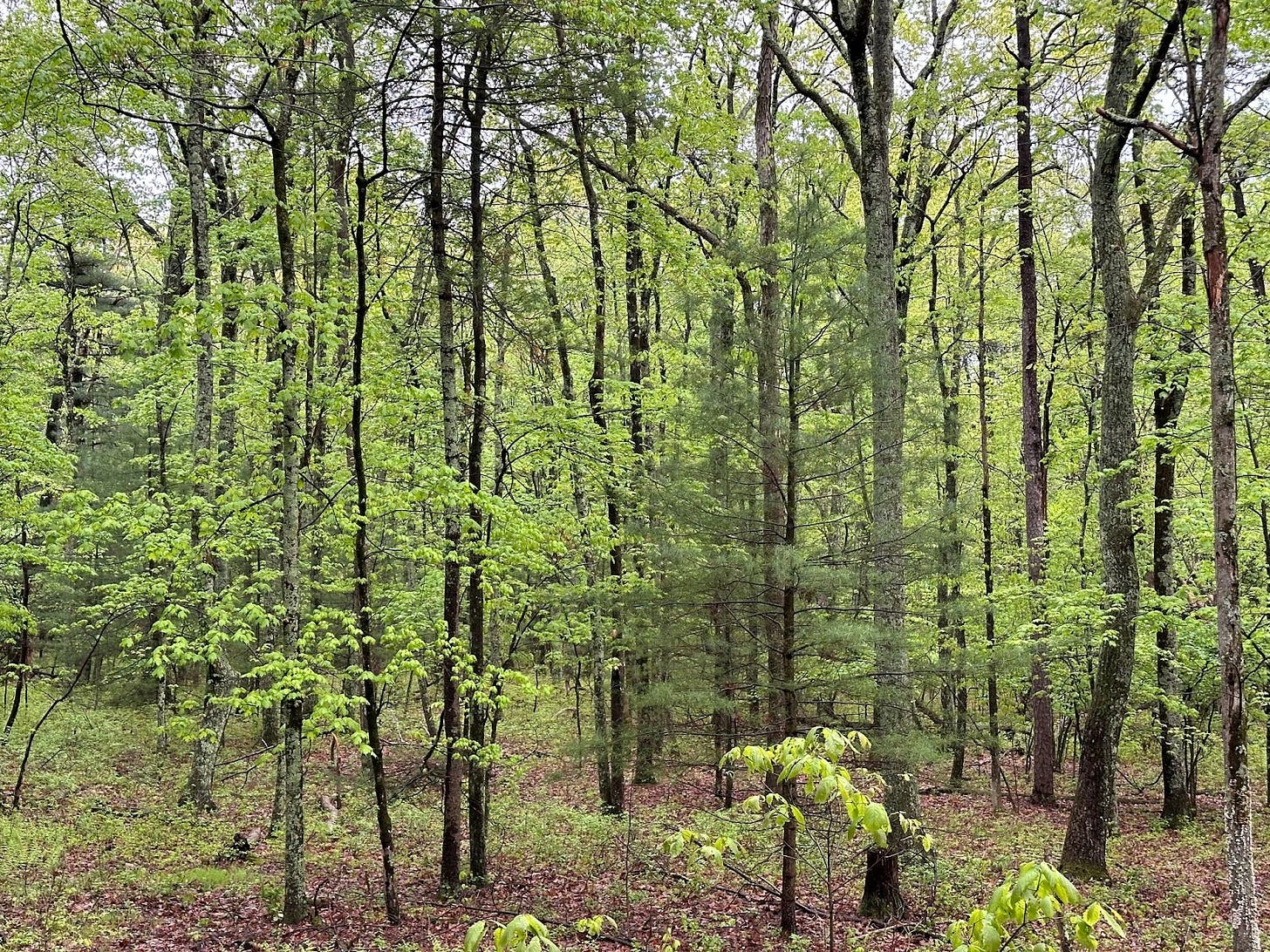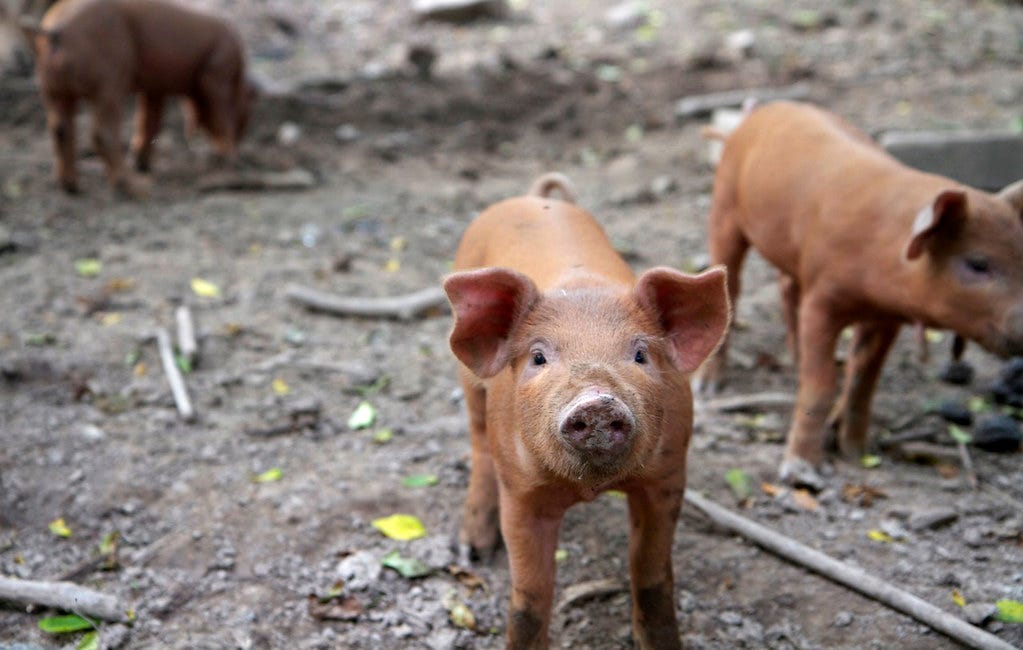It rained overnight, and when I woke up in the morning, opening my eyes to look out the bedroom window for the first time, all I saw was green. For months the view was stark, the aftermath of winter in the woods. And then suddenly the trees started to leaf out. Now all I see is green—and not a “forest green” like you might imagine if you close your eyes and think of the way it feels to be in the woods. It’s a blindingly bright, new green.
There have been cues of Spring’s arrival for months now. Daffodils were everywhere, sooner than expected just after the winter freeze started to recede. Brad and I watched the gardens of our Philadelphia neighborhood, surrounding the penitentiary and behind the art museum, begin to successively bloom. The irises flowered first in my own front garden, and then everywhere I looked. I sent pictures of “Iris Parties” to my oldest friend to share with his daughter named Iris.
In the Poconos, as we moved through April into May, I noticed ferns starting to uncurl. The days grew longer and warmer, and I began to spot the first growth of wild garlic mustard along the paths we walk. One afternoon Brad and I harvested an armful, and after plucking and washing the tender leaves, I requested that he make pesto. We ate it with some fish and roasted potatoes. It was excellent. The next armful of greens I sauteed to fold into quesadillas. We also simply mixed the young mustard leaves into our salad mix.
The next time I pointed out a flush of garlic mustard, Brad responded saying, “Heather, you can’t cook all this”. He has since become vigilant about yanking the greens and tossing them onto the paths to die. We need to control their invasive growth in the woods that surround us, and yet this feels like an act of resistance—as if he is afraid I’ll try to make us eat all of them. I’ve since turned my attention to the dandelions.
It’s been incredibly restorative to spend so much time in the woods, steeped in nature. We watch daily change and growth happen all around us. It encourages feelings of responsibility as environmental stewards, and a desire to better understand the ecosystem of the forest. Now when I find myself back in the city, I notice what’s green and growing around me more than I ever have before.
Meanwhile, in my professional life I am writing a protocol for a regenerative beef program. My work on this project took me on a walk through fields thigh high with the season’s first perennial grasses. The local farmers who accompanied me are graziers, utilizing beef cattle to leave behind nutrient-rich fertilizer and promote regrowth.
I am trying to put myself in the mindset of farmers who are focused on the soil health of grass pastures as I consider how we talk about and translate ideas of regeneration in practice. During a recent conversation, comparing our ideas and priorities around best practices, one of the farmers told me of colleagues who recently visited Ireland and Scotland to tour grass-fed beef operations. They were there in search of more viable models because Europe is at least a decade ahead of the US in terms of government regulations to protect the environment.
This is what was on my mind when I read a recent piece from the Yale School of the Environment, “Tracking Illicit Brazilian Beef from the Amazon to Your Burger””. It digs into the work of investigative journalist Marcel Gomes, who traced beef, often raised on illegally cleared land in Brazil, through JBS1 slaughterhouses and packing plants to retail outlets and fast-food restaurants around the world. “When his sleuths were done, the fingerprints of forest destruction were plain to see. Six of Europe’s biggest retail chains reacted by halting purchases of JBS beef.” In the U.S., major buyers did nothing.

Is this what you think of when you imagine a beef farm? It’s no longer a forest either.
Whether they intend to or not, most people purchase food from corporations that control nearly all the meat in our supply chains, produced in ways that pollute and deplete the resources we are becoming increasingly desperate to regenerate. It’s the source of the hamburgers at McDonald’s, but also the meat offered on many restaurant menus and sold in grocery store meat departments. So much destruction in pursuit of cheap, available food (in this case literal deforestation) is hidden from the public eye, disconnecting what we consume with how it was produced.
Often the defense for food production at such a devastatingly unsustainable scale is that there are so many people on our planet who need to eat. But if we consume the earth in the process of feeding people today, what resources will be left to feed the future?
I don’t have advice if you feel overwhelmed by this information. I feel that way too. My intention for sharing is to increase awareness, because we need to seek more transparency about where our food comes from and how it was raised, especially when it comes to animal proteins like meat and dairy. Our food systems have a long way to go from the current practices of deception to protect profit at all costs.
Small growers, local food producers, purveyors, and advocates like myself often work together at the regional level to build up responsible local food systems. But we are the minority, and it is the majority we need to push towards change. For farmers of all types and sizes, the immediate goal must be to not just to sustain, but to improve the quality and health of the earth through agriculture. This is what we mean when we talk about regenerative practices. It’s the only path to a future that is green.

Related Reads From The Hungry Heart Archive:
On Eating Animals (Part 1)
How little progress we've made in the shadow of 99%. Warning: This essay contains graphic descriptions of the killing of animals for food. However, if you eat meat, I strongly urge you to find the strength to read on.
On Eating Animals (Part 2)
If you missed “Part 1”, you can find it here, including a somber statistic from Jonathan Safran Foer’s book, Eating Animals: “Ninety-nine percent of all land animals eaten or used to produce milk and eggs in the United States are factory farmed.”
Green Food Rules
For us hungry folks, the most obvious arrival of Spring happens on our plates. In late April, I was lucky to attend two dinners showcasing rustic Italian cooking, hosted by Philadelphia chefs who I greatly admire for their commitment to local sourcing.
At Le Virtu, Chef Andrew Wood2 started off a special Abruzzese feast with a plate of crostini featuring asparagus, ramps, and fiddlehead ferns. These were my very first tastes of fresh, local greens, much of it harvested from the woods. The forager was in attendance at dinner.
On another night I cozied up to the chef counter at Heavy Metal Sausage Co.3, where Chef Pat Alfiero served us course after course of green food. The salad was dressed with a green garlic hollandaise. Then risotto featured asparagus and “too many wild herbs to mention”. The pasta was an inspired pairing of wild epazote pesto with braised oxtail and beans. And even the sauce over the local Birchrun Hills veal breast was green.
It is the star of Spring menus, but is eating asparagus worth it?
I ask this question every year when I am appalled by the smell of my “asparagus pee”. And yet every time I’m presented with the first local harvest of the season, I find it irresistible. I enjoy the spears simply rolled in a hot buttery pan until they’re crisp but tender, and served with a fresh squeeze of lemon. But I also love to make asparagus risotto (I love to make any kind of risotto with rich broth).
A hot tip for making asparagus risotto really green while using the whole vegetable is to trim and reserve the tips, then coarsely chop and blanch the stalks of the spears so they are tender enough to puree in a blender or food processor. When the risotto is nearly finished, gently sauté the tips in some butter, then fold them along with the green puree into the risotto.
Food For Your Brain
A recent article from
, “Vegan vs. Vegan”, featured an excerpt from The Good Eater: A Vegan’s Search for the Future of Food. In it, author Nina Guilbeault explores whether there is truly an ethical way for people to eat, acknowledging the complications of our food systems as well as our individual resources and choices. I’ve always considered myself to be on the same team as vegans and vegetarians who opt out of meat consumption for ethical reasons. It is our approach to the problems that differs.I am … a vegan who wishes that vegans and others in the food movement would stay focused on the problems of factory farming, rather than turn against each other. (Nina Guilbeault)
This Notable Sandwiches newsletter’s tribute to legendary record producer Steve Albini, who passed away recently, is pure gold. In addition to sending me to the wayback archive of Albini’s 2011 food blog, mariobatalivoice, it prompted me to recall an episode of the Conan O’Brian Needs a Friend podcast on which Dave Grohl, Krist Novoselic, and “In Utero” producer Steve Albini talk about the experience of being Nirvana and making “In Utero” on its 30th Anniversary. RIP Steve, we thank you for your gifts of great music and an even greater appetite.
Buy groceries and feed yourself, even on the road. Road food is terrible because the roadside eateries know the feeders will be hundreds of miles away before heartburn or diarrhea set in. For less than the cost of a Big Mac, fries and a Coke, you can buy a loaf of fresh bread and some good cheese or roast beef, which you will enjoy much more. (Steve Albini)
I’ve been having a lot of conversations like “You Are Not Alone” with small business owners and I know a lot of you connected to my recent piece about my bankruptcy. In this LA Times piece, “Where every cent of $1 goes at one L.A. restaurant, explained”, Botanica restaurant owner Heather Sperling presents a real breakdown of the current cost of doing small business. Spoiler alert: It doesn’t pay. It doesn’t even break even! How can this continue?
There is no way to balance the books without compromising the quality, vision and values that define a business like ours…And if we were to pass the costs on to our customers, we’d be compromising the vision and values that make us what we are. It’s an absolute conundrum. (Heather Sperling)
~
As always, thanks for reading and just being here.
XX, Heather
Have you heard of JBS? It is one of the biggest meat companies in the world. They supply a significant market share of meat that is barely traceable and ending up on American plates. A Washington Post article, “This foreign meat company got U.S. tax money. Now it wants to conquer America.” from 2019, stated that “a dozen years ago, JBS did not own a single U.S. meat plant. Today, JBS and three other food companies control about 85 percent of beef production.” Since then, JBS has only grown.
Andrew Wood was the first chef in Philly that I called a friend, forever bonded after we collaborated on a goat harvest and dinner at Wyebrook Farm back in 2014. The goat skull from that day was proudly displayed in the dining room at the former Russet—a beautifully personal and seasonal restaurant I will always miss.
To book a table at Heavy Metal’s after-hours trattoria, sign up for their mailing list!







